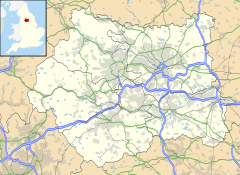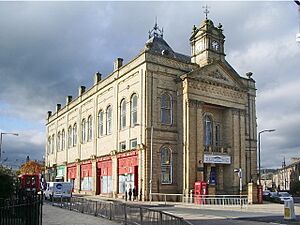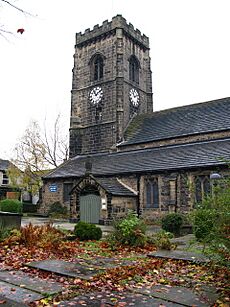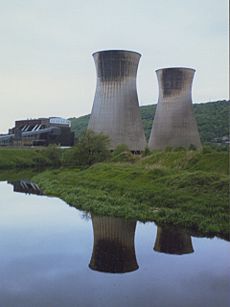Elland facts for kids
Quick facts for kids Elland |
|
|---|---|
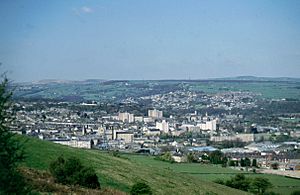 A view of Elland |
|
| Population | 11,676 (Ward at 2011 census) |
| OS grid reference | SE106208 |
| Metropolitan borough |
|
| Metropolitan county | |
| Region | |
| Country | England |
| Sovereign state | United Kingdom |
| Post town | ELLAND |
| Postcode district | HX5 |
| Dialling code | 01422 |
| Police | West Yorkshire |
| Fire | West Yorkshire |
| Ambulance | Yorkshire |
| EU Parliament | Yorkshire and the Humber |
| UK Parliament |
|
Elland is a busy market town in Calderdale, which is part of West Yorkshire, England. It sits south of Halifax, right next to the River Calder and the Calder and Hebble Navigation. Elland was first written about in a very old book called the Domesday Book in 1086. In 2011, about 11,676 people lived in the Elland area.
Contents
What's in a Name? The Meaning of Elland
The name Elland was first recorded as Elant in the Domesday Book from 1086. The name comes from two very old English words. Ēa means 'river' and land means 'land'. This name makes a lot of sense because the town is located on the south bank of the River Calder.
Elland's Past: A Look at History
Elland has a long history, even before the Normans took over England. The Elland family, who owned the land, were descendants of Anglo-Saxon nobles. The area of Elland, along with nearby Greetland and Southowram, was a special part of a larger estate called the Honour of Pontefract.
In 1350, a man named Sir John de Eland was sadly murdered. His son and grandson were also killed the next year. This meant the family line ended, and the land passed to the Savile family. After this, the main house in Elland was no longer the main home for important families. The Saviles lived at their own large house called Thornhill.
The old Elland manor house was never fully rebuilt. When it was carefully taken apart and studied in 1975, experts found a part of it from the 13th century. This makes it one of the oldest non-religious buildings in the county. The manor house used to stand on a small hill near the bridge over the River Calder. It was taken down when a new road, the Calderdale Way bypass, was built. However, some of the old farm buildings still remain today.
In the past, the King of England, Edward II, gave permission for Elland to have a free market every Tuesday. This was a big deal because it helped the town's economy. Elland also had two fairs, which were like big festivals and trading events.
Elland became an important place for making wool. Over time, the wool industry changed, and many of the old mills were either taken down or turned into homes.
Strong flagstones, known as Elland flags, were dug up near the town. Once the canal was built, these stones could be easily moved all over the county. Elland was also home to the main factory for Gannex products. Today, it's where the Dobsons sweet factory makes traditional boiled sweets. Since 2001, Suma Wholefoods, a large company run by its workers, has been based in Elland.
How Elland is Governed
Elland used to be a 'township' with Greetland, part of the big parish of Halifax. In 1866, it became a 'civil parish'. Then, in 1894, Elland separated from Greetland and became its own 'Urban District'. In 1937, Greetland and Stainland joined the Elland Urban District. Finally, in 1974, the Urban District was ended, and Elland became part of the Calderdale Metropolitan Borough.
Cool Places to See in Elland
There are several interesting buildings in Elland. These include the parish church of St Mary the Virgin, the old Rose and Crown Inn, and the Elland Town Hall. You can also see the Southgate Methodist Church, the Rex Cinema, and Waxman ceramics.
At the corner of Southgate and Elizabeth Street, you can find the remains of the medieval stocks. These stocks, which are a protected historical site, were used in the late 1600s or early 1700s.
Elland Power Station: A Look Back
Elland used to have a coal-fired power station right by the River Calder. It stopped working in 1991 and was taken down in 1996. This happened as power generation moved to fewer, larger stations outside of towns.
Getting Around: Transport in Elland
The Calder and Hebble Navigation is a canal that opened in the late 1700s. It helped transport goods during the Industrial Revolution in the Calder Valley.
The Elland railway station closed in 1962, but the train line is still used for passenger services on the Caldervale Line. There are plans to reopen the station. If it reopens, people could travel directly to Leeds, Bradford, Halifax, and Huddersfield. As of March 2023, the plans for the new station were approved. Building work is expected to start in 2024 and finish in 2025.
The A643 road starts in Leeds and used to end in Elland. It passes by Leeds United's football ground, Elland Road. Now, it ends at junction 23 of the M62 motorway. The Elland bypass road was built between 1976 and 1978. It cost about £8.5 million and was opened on December 13, 1978.
Media and News
Local news and TV shows for Elland are provided by BBC Yorkshire and ITV Yorkshire. TV signals come from the Emley Moor and local relay transmitters.
You can listen to local radio stations like BBC Radio Leeds, Heart Yorkshire, Capital Yorkshire, Hits Radio West Yorkshire, Greatest Hits Radio West Yorkshire, and Phoenix Radio, which is a community station.
Local newspapers include the Halifax Courier, the Telegraph & Argus, and the Huddersfield Daily Examiner.
Famous People from Elland
- Thomas Thornton (1922–1987), a first-class cricketer.
See also
 In Spanish: Elland para niños
In Spanish: Elland para niños
- Ellands, a surname
- Elland (UK Parliament constituency)
- Listed buildings in Elland


